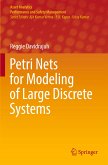This book addresses the need for users to understand the internal workings of GPenSIM's functions, including their design and how they can be extended to model and analyze scenarios that were previously not possible. It presents previously unavailable internal details of these functions, demonstrating how systems that could not be modeled in the past can now be analyzed by extending the capabilities of the GPenSIM tool. This book concentrates on the internal mechanics of the GPenSIM tool, specifically aimed at benefiting tool developers and designers. GPenSIM is a tool for modeling discrete systems, widely used in many universities around the world. The author of this book developed GPenSIM, which has been utilized to model various practical scenarios. Users often seek to understand the inner workings of GPenSIM, such as its design and its integration with other tools. This book addresses these aspects and acts as a reference manual for GPenSIM, helping users quickly grasp the various ways to utilize its functions and how these can be tailored to specific cases.One of the notable features of GPenSIM is its tight integration with MATLAB. This not only facilitates easy deployment and operation but also allows users to leverage MATLAB's extensive libraries for practical applications across various fields. The details provided in this book, along with its structured format, will greatly assist both university students and practicing engineers.
Bitte wählen Sie Ihr Anliegen aus.
Rechnungen
Retourenschein anfordern
Bestellstatus
Storno








